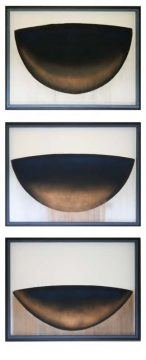by Timothy Don
The current economic crisis is crushing artists, museums, and galleries everywhere. In the San Francisco Bay Area, where I live, an exorbitant rental market made maintaining a practice difficult before this crisis hit. It’s even harder now. With 3QD’s permission, I’m going to use this column to talk about the work of some of the artists and art professionals I have met here. I ask you to support artists wherever and however you can.

Peter de Swart, works on paper: Triptych
The triptych form is associated with religious painting. It first appeared as a feature of early Christian art and became popular for altar paintings and devotionals during the Middle Ages. While Peter de Swart’s Triptych is not overtly religious, it emanates an undeniably religious or spiritual aura. It is, in a word, numinous. To encounter this painting is to witness a sacred transaction. You’d have to be a stone to look at it and not experience a yearning for the divine. Why, apart from its rearticulation of the history and symbolism of the triptych form, is that?
It must have something to do, first of all, with the simple purity of the object pictured, which appears to be a bowl of some sort. Bowls are one of those inventions (like scissors or chopsticks or the hourglass) that we got right the first time. They were perfect the moment they appeared. In the bowl, function lives harmoniously with form. Its shape is so ideal as to be almost Platonic. Furthermore, bowls are used to prepare and serve food and drink, which means that they give sustenance, enable shared meals, and consequently help to strengthen communal bonds and deepen human relationships. Finally, bowls are vessels. Like hands and pockets and ships, they hold and contain and convey things—but they are not grasping like hands, nor like pockets do they secret away their contents, and they don’t trade goods and gold like ships. Quite the opposite, in fact: Bowls are generous, open, gratuitous. They give away the things they hold.
All of these attributes (form, use value, ethos) lend bowls a quasi-spiritual redolence, but they do not make bowls sacred. If this triptych depicted a bowl no different from any other bowl, then its effect would be decorative rather than numinous. This bowl is special. Again we must ask: Why is that? Read more »
